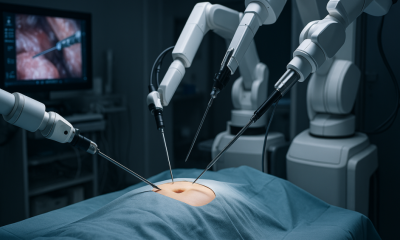Robotics
Bipedal Robot Combines Walking and Flying to Navigate Rough Terrain

A bipedal robot that combines walking and flying to create a new type of locomotion was developed by researchers at Caltech. This new combination enables the robot to carry out complex movements.
The robot is a mix between a walking robot and a flying robot, and it is called LEONARDO, or LEO for short. It is able to walk a slackline, hop, and ride a skateboard.
The robot was developed by a team at Caltech’s Center for Autonomous Systems and Technologies (CAST), and it’s the first robot to use multi-joint legs and propeller-based thrusters to achieve control over its balance.
The research was published on October 6 in Science Robotics.
Soon-Jo Chung is corresponding author and Bren Professor of Aerospace and Control and Dynamical Systems.
“We drew inspiration from nature. Think about the way birds are able to flap and hop to navigate telephone lines,” says Chung. “A complex yet intriguing behavior happens as birds move between walking and flying. We wanted to understand and learn from that.”
“There is a similarity between how a human wearing a jet suit controls their legs and feet when landing or taking off and how LEO uses synchronized control of distributed propeller-based thrusters and leg joints,” Chung adds. “We wanted to study the interface of walking and flying from the dynamics and control standpoint.”
Bipedal Robots
Bipedal robots use movements like humans to navigate real-world terrains, and these movements can include running or jumping. However, rough terrain often makes it difficult for this to happen. Flying robots are able to easily navigate this same rough terrain by flying above it, but they are also hindered by high energy consumption during flight and limited payload capacity.
Kyunam Kim is a postdoctoral researcher at Caltech and co-lead author of the paper.
“Robots with a multimodal locomotion ability are able to move through challenging environments more efficiently than traditional robots by appropriately switching between their available means of movement. In particular, LEO aims to bridge the gap between the two disparate domains of aerial and bipedal locomotion that are not typically intertwined in existing robotic systems,” says Kim.
Developing a Hybrid Movement
The researchers tried to get around this by relying on a hybrid movement that is between walking and flying. LEO has lightweight legs that take stress off its thrusters by supporting a large amount of the weight.
Patrick Spieler is co-lead author of the paper.
“Based on the types of obstacles it needs to traverse, LEO can choose to use either walking or flying, or blend the two as needed. In addition, LEO is capable of performing unusual locomotion maneuvers that even in humans require a mastery of balance, like walking on a slackline and skateboarding,” says Spieler.
LEO is 2.5 feet tall and has two legs with three actuated joints, as well as four propeller thrusters that are mounted at an angle at the robot’s shoulders. LEO’s propellers help keep it upright as it walks, and the leg actuators change the position of the legs to move the robot’s center of mass forward, which it does through the use of a synchronized walking and flying controller. When LEO is flying, it operates like a drone and uses just the propellers.
Elena-Sorina Lupu is a graduate student at Caltech and co-author of the paper.
“Because of its propellers, you can poke or prod LEO with a lot of force without actually knocking the robot over,” says Lupu.
The team will now look to improve LEO’s performance by developing a more rigid leg design that can support more weight, and they will also look to increase the thrust force of the propellers. Another goal is to make LEO more autonomous and to equip it with a newly developed drone landing control algorithm.
“Right now, LEO uses propellers to balance during walking, which means it uses energy fairly inefficiently. We are planning to improve the leg design to make LEO walk and balance with minimal aid of propellers,” says Lupu.











